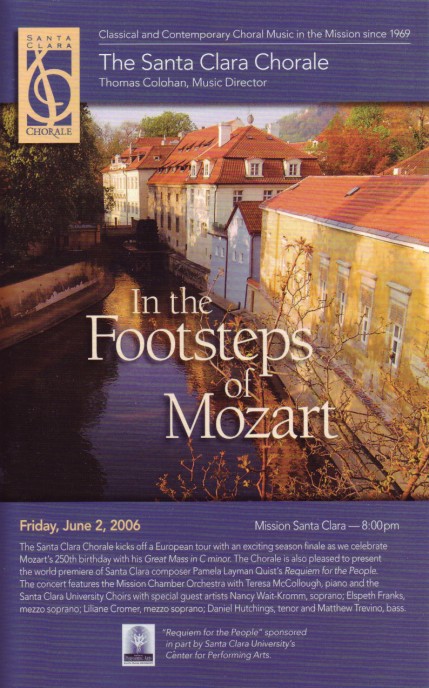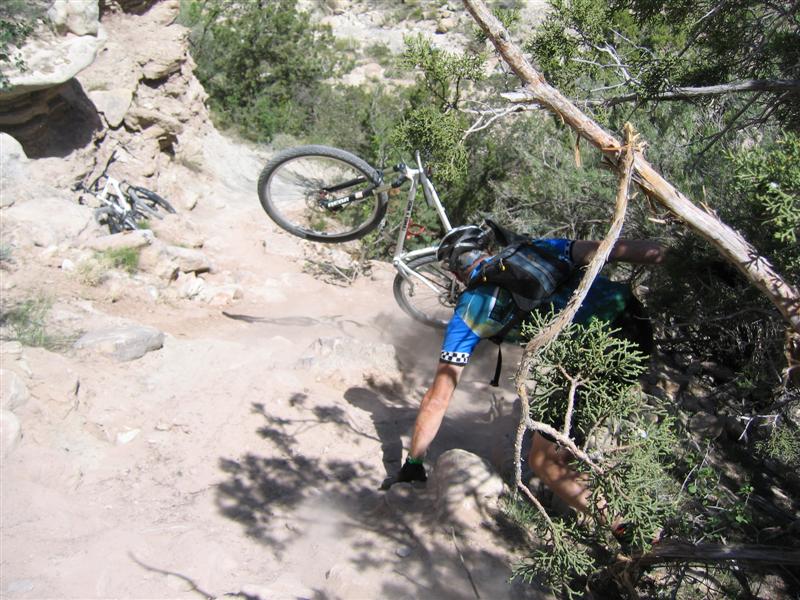 Requiem for the People
Requiem for the People, a new work by Santa Clara University Composition Professor Dr. Pamela Layman Quist, will be premiered by the Santa Clara Chorale, the Santa Clara University Choral Ensembles, and the Mission Chamber Orchestra on Friday, June 2, 2006 at 8:00p.m. in the Mission Church. This twenty-five minute work for chorus and orchestra was commissioned by the Santa Clara Chorale following an invitation from the Prague Radio Symphony Orchestra to perform in the Dvorak Festival in Prague, Czech Republic.
“It’s a thrill to be premiering this marvelous work here and in Europe,” said Thomas Colohan, director of both the Santa Clara Chorale and the Santa Clara University Choral Ensembles, who will be touring with
Requiem for the People later in June. “The work is sophisticated and gorgeous, and the singers absolutely love singing this piece. Dr. Quist has made a significant contribution to the choral repertoire.”
Starting with an accompanied soprano solo,
Requiem for the People developed into an intricate, six-movement form inspired by personal events combined with the public tragedy of September 11, 2001. “
Requiem for the People addresses a range of universal spiritual thought and human emotion, and I intend for this work to have meaning for a diverse listening audience,” explains Dr. Quist. “Each movement contains a dedication to a different group of people whose lives and deaths have held great significance for us in varying ways.”
An accomplished composer and teacher, Dr. Quist describes the compositional process as “a bit like describing why one decided to give birth to a child. Some creations are dreamt of and planned—some just happen. Both kinds are blessings.” In addition to her work at SCU, Dr. Quist co-founded the Walden School, a summer school and music festival for young composers. She received her education at the Peabody Conservatory of Music, and in 1984, received a Doctoral degree in music composition from Johns Hopkins University.
Dr. Quist’s compositions from recent years include
Revival for guitarist, Bryce Dessner (2004);
Ice Dance for Clogs (2003);
Rune for cello and piano (2000);
Caelestis formam gloriae, a choral work with string quartet commissioned for Transfiguration Sunday (1999); and
Dyad for oboe/english horn and piano (1998). Her most performed work to date remains the 1996 solo piano work
Homage.
[ . . . ]
The concert will also include Mozart’s Mass in C minor “The Great,” in celebration of Mozart’s 250th birthday.
(
Source)
To catch the premier of a new composition before it embarks on a tour of Europe! What a treat!
Program NoteLyrics & Translation
The concert was held on a cool Friday night at the
Mission Santa Clara de Asís. Conducted by the über-talented Music Director,
Thomas Colohan, the power--and yet, agility and delicacy--of the
154-strong chorale was breathtaking. Soloists: 1 soprano, 2 mezzo sopranos, 2 tenors, and 1 bass. The main body: 23 first sopranos, 24 second sopranos, 28 first altos, 22 second altos, 9 first tenors, 9 second tenors, 21 baritones, and 12 basses.
As there is a very small chance that someone in Europe (who is
also planning to attend the concert) is reading this, I will reveal the surprise at the end of
Requiem for the People: at conclusion of the 5th movement,
Benedictus, all 154 members of the choir leave the stage. They proceed to form a single line, encircling--and facing--the audience. All around you, you see them. Even the exits are blocked. The lights dim. There is a general feeling of being trapped, hemmed in.
The choir members--men in their crisp tuxedos, women in full-length dresses--uniform in their black attire, stand there, silent, sentinel, seemingly a wordless reminiscence of horrors past. The minutes tick by, but they do not move, smile, or say anything. A few people start hyperventilating.
Then, rising and falling in volume, they begin to mutter, whisper, hiss and rasp in otherworldly voices. One side would mute, letting the other side rise in volume, and then the process will repeat itself. These would have been easily dismissed as cheap theatrics if not for its efficacy in making your hair stand on end.
As the mutterings and hissing mercifully fade away and the lights brighten once more, the chorale, still encircling the audience, launch into the final movement with a crescendo:
VI.
Agnus DeiAgnus Dei, qui tollis peccata mundi,
dona eis requiem.
Agnus Dei, qui tollis peccata mundi,
dona eis requiem sempiternam.
Lux aeterna luceat eis, Domine,
cum sanctis tuis in aeternum,
quia pius es.
Requiem aeternam dona eis, Domine,
et lux perpetua luceat eis,
cum sanctis tuis in aeternum,
quia pius es.
TranslationVI.
Agnus DeiLamb of God, who takest away the sins
of the world, grant them rest.
Lamb of God, who takest away the sins
of the world, grant them everlasting rest.
May the eternal light shine on them, O Lord.
with Thy saints forever,
because Thou art merciful.
Grant the dead eternal rest, O Lord,
and may the perpetual light shine on them,
with Thy saints forever,
because Thou art merciful.
We were blown away.
Some of the audience decided to call it a night after this, their emotional capital exhausted by the disturbing prelude to the final movement of
Requiem for the People. Those of us who chose to remain after the intermission were treated to Wolfgang Amadeus Mozart's
"Great" Mass in C minor for soloists, choir and organ--which was doubly appropriate given that this year is the the composer's 250th birthday, and that the concert is being held in a church.
Mozart composed the
"Great" Mass in C minor as a
wedding gift for his wife, Constanze Weber. Constanze was a soprano, and this probably explains for the many soprano parts in this piece. In fact, when it was first performed on August 25, 1783 in St. Peter's Church, Salzburg, Constanze herself took one of the soprano solo parts. Sadly, Mozart died before he could complete the entire work.
The soprano solos were unbelievably gorgeous. In the first movement, the chorus open
'Kyrie' somberly, but is quickly followed by a soaring soprano solo in the
'Christe' section; the two then join together to complete the final
'Kyrie' portion of the movement. Later, there is a stunning duet for two sopranos and accompanying strings in the
'Domine Deus.'The evening concluded with Professor Quist receiving a standing ovation for her composition. Her piece rendered all the more gorgeous by the wonderful musicians, of course.
 Control.
Control. Confidence.
Confidence. Peer pressure.
Peer pressure. Faith.
Faith. Trust.
Trust. Wade Simmons, Committed.
Wade Simmons, Committed. View from the cockpit.
View from the cockpit. Rock and moss.
Rock and moss. Rock and ladders.
Rock and ladders. Twin Arches, Amasa.
Twin Arches, Amasa. Sub Rock, Sedona.
Sub Rock, Sedona. Bartlett's Wash.
Bartlett's Wash. Bartlett's Wash II. This guy is 55 years old.
Bartlett's Wash II. This guy is 55 years old. Gentlemen, we have lift off!
Gentlemen, we have lift off! Attempting recovery.
Attempting recovery. Unsuccessful! (Watches buddy tumble down the hill).
Unsuccessful! (Watches buddy tumble down the hill). Visualizing the line.
Visualizing the line. Going for it.
Going for it. Another one.
Another one. Pressure Suit.
Pressure Suit. Crash Pad.
Crash Pad. Elbow and Forearm Guards.
Elbow and Forearm Guards. Knee and Shin Guards.
Knee and Shin Guards. Kira hiking up with bike, all 112 lbs (51 kg) of her.
Kira hiking up with bike, all 112 lbs (51 kg) of her. Mentally preparing for the downhill. (Her body armor is apparent under her clothes.)
Mentally preparing for the downhill. (Her body armor is apparent under her clothes.) Going for it. She's got more cojones than many men I know.
Going for it. She's got more cojones than many men I know.


